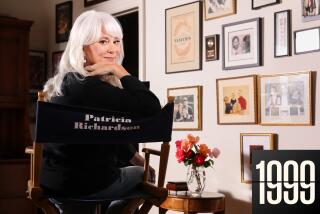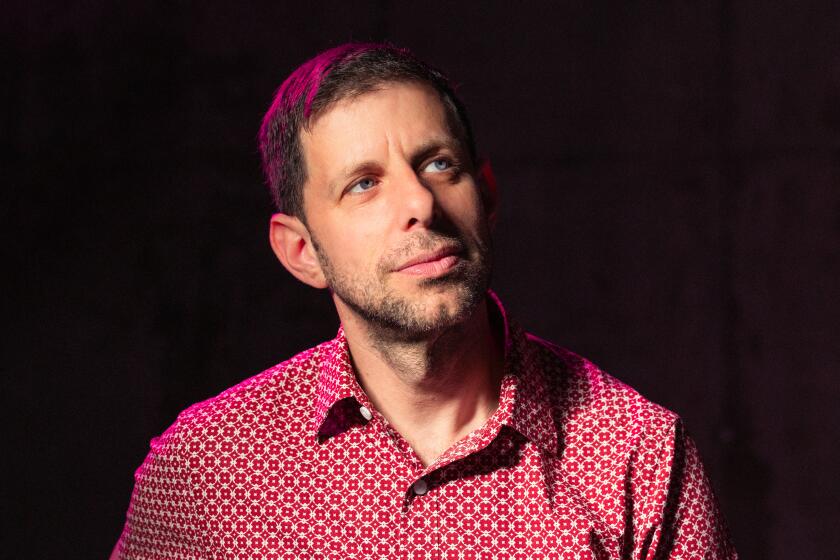The Wisdom of the Past : In exploring the current status of Chicanos, the play “August 29” recalls a 1970 protest and the killing of journalist Ruben Salazar
Politics and the arts have always been intertwined in the Chicano movement--El Movimiento. Cesar Chavez’s efforts beginning in the mid-’60s in Central California to unionize farm workers were dramatized by Luis Valdez’s Teatro Campesino--a company that was founded in 1965 and inspired countless Chicano theater groups, which used the stage to explore other political issues, including the Vietnam War, job discrimination and immigration policies. The political awakening of La Raza--”The Race”--was also played out against the backdrop of murals in cities across America. But, since those fiery beginnings, social gains have led to increased assimilation and somewhat cooled the fervor of the Chicano spirit. In turn, the number of Chicano theater groups has diminished and Chicano art was homogenized when it entered the mainstream commercial art world. Here in Los Angeles, scene of early ‘70s protests and boycotts, an upcoming theater production and a retrospective exhibition recall the spirit of La Raza and help cast some perspective on the evolution of Chicano politics. (A contemporary manifestation of Chicano awareness is the rap music of Kid Frost. Despite his controversial use of gang imagery, the East L.A. rapper is stirring pride among the younger generation with his hit single “La Raza.” Page 8.)
On an early August evening at the Los Angeles Theatre Center, members of the center’s Latino Theatre Lab are gathered for a rehearsal. Downstairs, the three Latinos in the comedy group Culture Clash are performing, and in the audience are members of El Teatro Campesino--in town for performances at another venue.
In this building on this night is an impressive array of Latino--primarily Chicano--stage artists. They are products of one of the youngest theatrical movements in this country, linked directly to a larger political awakening.
The Chicano movement grew out of the conflicts between growers and farmworkers in the fields of central California in 1965. What started out as a rural concern quickly spread to cities throughout the Southwest as Chicanos began to question their societal standing.
Chicano theater companies were spawned throughout the region, creating and producing work about discrimination and inequality.
Now, LATC’s Latino Theatre Lab is continuing--and updating--the tradition with “August 29.” The title of the play, which opens Thursday, refers to the day in 1970 when the Chicano Moratorium was held in East Los Angeles. A reported 20,000 people marched to protest the Vietnam War, the disproportionate number of Chicano deaths in that war and the community’s general welfare.
After reports of a disturbance at a liquor store in the area, a riot broke out. As police and protesters clashed in and around Laguna Park, officers congregated at the Silver Dollar bar on Whittier Boulevard where they had received reports that a man with a gun was inside. A sheriff’s deputy fired a tear gas projectile into the bar and journalist Ruben Salazar was struck and killed. Salazar had become a voice for Chicanos, writing about their anger over injustices and police brutality in East L.A., and to this day, some people believe law enforcement authorities knew Salazar was in the bar and that the killing was a setup.
That pivotal event is the departure point in the “August 29” script, which is credited to “Violeta Calles”--a play-on-words translation of the Spanish for “violent streets,” and a pseudonym for the members of the five-year-old lab who collectively wrote the play. In the show, which is set in the present day, Salazar (E.J. Castillo) reappears to help college professor Lucero Trevino (Evelina Fernandez) finish her book about the Chicano movement. Trevino is not haunted by Salazar, but she is haunted by having lost the community spirit that once inspired her to lead school walkouts.
Trevino is now a “Chuppie”--a Chicano yuppie--with a BMW and a tenure-track teaching post. She is confronted by friends and acquaintances who want her to get involved in a case involving the shooting of one of her students by a police officer. When she hesitates, fearing involvement might threaten her chance at tenure, she is accused of spurning the community and movement that helped make her success possible.
The crux of the question the play poses: What has happened to the spirit of the movimiento?
“I know we’ve lost something,” says Fernandez, who was born and raised in East Los Angeles and now lives in Montebello. “That’s not to say we don’t care what’s happening to us politically, but we’ve lost that community struggle. Everyone’s out for themselves, which is very strange for our culture. We’re assimilating not just the positive things (about Anglo culture), but the negative things as well, like individualism. Everyone is out for themselves and that’s what’s changed.”
“Two years ago, we started doing research in the community about doing a piece for and about L.A.,” said Jose Luis Valenzuela, director of “August 29” and of LATC’s Latino Theatre Lab.
“We did a lot of interviews and asked people what they wanted to see, and many said they wanted a piece that would give them pride because we don’t really have heroes . . . and they kept on bringing up the moratorium.
“We started working on a piece, but focusing on Ruben didn’t occur to us until a year later. We wanted to ask, ‘What would you do in (the teacher’s) situation? Is it worth (getting involved), just because the police killed somebody?’
“We wanted to talk about the movement, not about Ruben Salazar. But his death made him a martyr. When we were doing interviews in the community, many people told us how every Friday they waited for his column.”
Salazar was in many ways an unlikely player in the Chicano movement. He was, in fact, a native of Juarez, Mexico, whose experience was quite different from that of Mexican-Americans--very few of whom had careers as journalists.
After working at several other U.S. newspapers, Salazar came to The Times in 1959, where his assignments included the revolution in the Dominican Republic and the Vietnam War. Later, he became the Times’ bureau chief in Mexico City.
He once described himself as “middle-class Establishment,” and his Anglo wife and their Orange County residence bore out that description. Some acquaintances told “August 29” researchers that Salazar possessed a mild disdain that Mexican citizens are sometimes known to have for Americans of Mexican descent. According to the “August 29” storyline, Salazar was disinterested in Chicano affairs until he was prodded by activists to report about community concerns after the shooting of two brothers by an L.A. police officer.
By the time of the moratorium, Salazar had left the staff of The Times to become news director for KMEX-TV. He continued writing a weekly column for The Times, and the problems he discovered in the Chicano community apparently gave Salazar a new perspective. His widow, Sally, once wrote that in his final months, Salazar “was someone he himself may have just been in the process of discovering.”
Salazar’s writing was in many ways an introduction for Anglo readers to a vast and growing community they knew little of. One of his columns was essentially a primer, titled “Who Is a Chicano? And What Is It the Chicanos Want?”
In trying to explain why people were adopting the term Chicano , Salazar wrote: “Mexican-Americans, though indigenous to the Southwest, are on the lowest rung scholastically, economically, socially and politically. Chicanos feel cheated. They want to effect change. Now.”
There have certainly been changes in Chicano theater. Luis Valdez has gone from the lettuce fields to Broadway and Hollywood. His Teatro Campesino trained and set loose the first generation of Chicano stage artists, many of whom have gone on to mainstream stage, television and film work.
The number of teatros has fallen considerably, but the strongest have survived. If they are not thriving, they have at least improved their lot.
There are now groups like Latins Anonymous, whose show comedically laments being a Latino actor in Hollywood. Then there’s Culture Clash, the three irreverent, young Latinos currently performing “The Mission” at LATC, who have even been known to parody el movimiento and teatro colleagues in their work.
Riding through East L.A., “August 29” director Valenzuela--who also spent time in Santa Barbara with Teatro de la Esperanza (now based in San Francisco)--points to a modest building where he produced his first theatrical piece in Los Angeles in 1969. Now, he sits in the cozy environment of the L.A. Theatre Center where, as director of the Latino Theatre Lab, he has access to state-of-the-art, high-tech facilities.
“When we did our research for this show, we started to realize that we had become comfortable,” he says. “Chicano theater grew out of the movement so we asked ourselves, ‘What responsibility are we taking now?’ The younger generation doesn’t even know our history.”
Valenzuela, like Salazar a native of Mexico, says there is still a place for the sometimes didactic style of teatro Chicano.
“We’re still in the process of knowing our own history, even from 20 years ago. Teatro has to come out of a need . . . a community demand.”
Evelina Fernandez lived on Rowan Avenue in East Los Angeles, three blocks from what was then known as Laguna Park. On that fateful August day in 1970, the 15-year-old girl made her way to the park. Her motives, however, weren’t political like those of her character in the play.
“I was at the moratorium because I was curious,” Fernandez says. “I had a boyfriend who was going to be there. We heard there was going to be music and we thought it was going to be a party.
“(The moratorium) caused a lot of conflict in our family because my brother was in the Navy and was very patriotic at the time. He was very upset at all these (protesters) because of what they were doing.
“Right when we got to the park we were tear-gassed. I’ll never forget how we felt. The people that lived in the neighborhood were shocked.
“When (a character in the play) asks, ‘What are all those police cars doing in the schoolyard?’, that’s what my mother mother said as she looked at the police gathering at Rowan Elementary School. It never occurred to us that they were going to attack innocent people.”
Twenty years later, Fernandez says there is widespread misunderstanding about life in East L.A.
“Being born and raised there, I’ve never felt the danger or threat that people believe exists. The reputation that East L.A. has is blown way out of proportion.”
Still, she admits there’s a larger problem than public perception facing the Chicano community.
“I think if we get angry enough about something, like when we were angry about our brothers getting killed in Vietnam, then we can accomplish something. But we’ve become complacent. The issues have changed. It’s now things like the environment. But there is so much happening in our communities, so many things to be angry about, like the gang and drug activities. I don’t know what the answer is. We have the potential to be such a power in this city. It all goes back to unity and speaking in one voice . . . being angry enough to say ‘Ya basta,’ that’s enough.”
One recent morning, a man and a young boy stood talking outside the door of the bar now known as The New Silver Dollar. They walked across Whittier Boulevard and the man raised his arms, pretending to hold a rifle. Pointing toward the bar, he fired an imaginary shot, and was overheard telling a story to his 11-year-old son, Francisco.
“They killed him,” the man said, “because he was stirring up the people.”
The boy shook his head, seemingly in disbelief.
The man continued his story, angrily recapping the 20 years since the Chicano moratorium and the death of Ruben Salazar.
“Nothing’s changed,” he said.
More to Read
The biggest entertainment stories
Get our big stories about Hollywood, film, television, music, arts, culture and more right in your inbox as soon as they publish.
You may occasionally receive promotional content from the Los Angeles Times.






